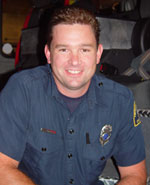Steve Whitehead: Guest Blogger from The EMT Spot

EtCO2 and the Return of Spontaneous Circulation
by Steve Whitehead
From a medical perspective, I didn't give Amanda much of a shot. Her presenting rhythm was asyslole. Reports on scene suggested that her total down time might have been as little as three minutes, or maybe longer. Her skin and body temperature suggested that she hadn't been down long and she had received fairly good CPR from her family. But asystole...you know how that goes.
We pulled out all the stops. One successful intubation, an IO line and a round of drugs later we were enroute to the emergency room with lights flashing and siren wailing. That's when I first noticed it, her capnography I mean. Amanda's capnography had shown an ETCO2 of 11 immediately following intubation and was hovering closer to 9 for the duration of her work-up. But now, now it registered 23.
"Where did that come from?" I wondered aloud. Her ECG tracing was still buried beneath the artifact of CPR waves, but I immediately knew something was going on with Amanda's heart. "Whoa guys, stop CPR. Check for a pulse." I announced.
In the electronic stillness of her pulse check I could see small but distinct QRS spikes. "No pulse." was the initial response. Under other circumstances I'd call for the resumption of CPR, but an ETCO2 reading of 23? "Check again." I politely requested. Now everyone started checking. Adam on the right femoral artery was the first one to find it. Then slowly but surely everyone recognized it, a strong and growing peripheral pulse.
We make a big deal out of using our inline capnography to confirm tube placement in cardiac arrest and for good reasons. Nothing objectively documents the correct, ongoing placement of your tube like a capnography waveform. But in the rush to sing the praises of capnography as tube validation, we sometimes forget another critical reason to have it in place; it can serve as an early indicator of return of spontaneous circulation. (ROSC)
I had learned about capnography's benefits as an early indicator of ROSC, but I had never witnessed it. That is, until I meet Amanda.
Related stories:
Firefighters Give 81-Year-Old Another Chance at Life
Sudden Cardiac Arrest Victim Saved at Twins Baseball Game
ZOLL End Tidal CO2
*Guest bloggers are not compensated by ZOLL, and ZOLL does not necessarily represent or endorse the opinion of the blogger.
